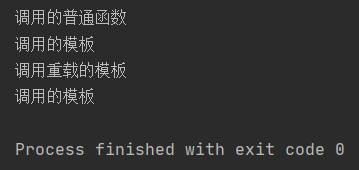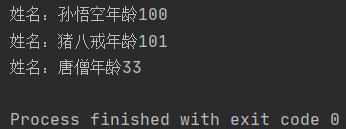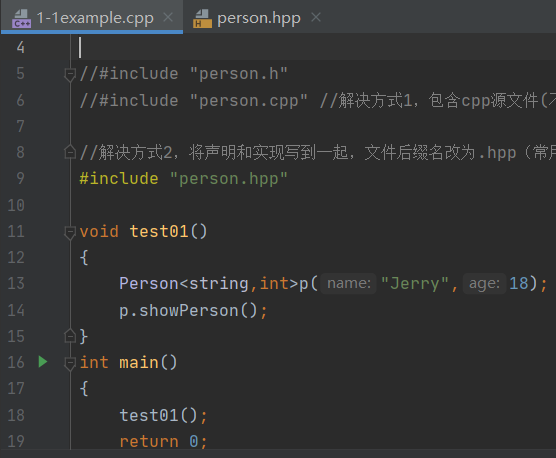文章目录
本博文是学习黑马程序员C++视频时做的笔记,记录一下只是方便温故知新,不做其他用途。
一、模板的概念
1、模板的特点:
(1)不可以直接使用,它只是一个模板;
(2)模板的通用不是万能的。
2、C++提供两种模板机制:
(1)函数模板;
(2)类模板。
二、函数模板
2.1 函数模板的基本语法
语法:
template<typename T>
模板有两种使用方法:
(1)自动推导类型,例如myswap(a,b);
(2)显示指定类型,例如myswap(a,b);
#include<iostream>
#include<string>
using namespace std;
//模板的基本语法
template<typename T>//声明模板
void myswap(T &a,T &b)
{
T temp = a;
a = b;
b = temp;
}
void test01()
{
int a = 10;
int b = 20;
// 两种方式使用函数模板
// 1 自动推导类型
// myswap(a,b);
// cout<<"a = "<<a<<endl;
// cout<<"b = "<<b<<endl;
// 2 显示指定类型
myswap<int>(a,b);
cout<<"a = "<<a<<endl;
cout<<"b = "<<b<<endl;
}
int main()
{
test01();
return 0;
}

2.2函数模板的注意事项
(1)自动推导类型,必须推导出一致的数据类型T才可以使用
(2)模板必须确定出T的数据类型才可以使用。
#include<iostream>
#include<string>
using namespace std;
//模板的注意事项
template<typename T>//声明模板
void myswap(T &a,T &b)
{
T temp = a;
a = b;
b = temp;
}
//1、自动推导类型,必须推导出一致的数据类型T才可以使用
void test01()
{
int a = 10;
int b = 20;
char c = 'c';
// 两种方式使用函数模板
// 1 自动推导类型
myswap(a,b);//正确
// myswap(a,c);//报错,类型不一致
cout<<"a = "<<a<<endl;
cout<<"b = "<<b<<endl;
}
//2、模板必须确定出T的数据类型才可以使用。
template<typename T>
void func()
{
cout<<"func 调用"<<endl;
}
void test02()
{
// func();//错误
func<int>();//正确,指定函数模板的数据类型为int。
}
int main()
{
test01();
test02();
return 0;
}

2.3 函数模板案例-数组的选择排序
#include<iostream>
#include<string>
using namespace std;
//交换的函数模板
template<typename T>
void mySwap(T &a, T&b)
{
T temp = a;
a = b;
b = temp;
}
template<typename T>
//利用选择排序,进行对数组从大到小的排序
void mySort(T arr[], int len)
{
for (int i = 0; i < len; i++)
{
int max = i; //最大数的下标
for (int j = i + 1; j < len; j++)
{
if (arr[max] < arr[j])
{
max = j;
}
}
if (max != i) //如果最大数的下标不是i,交换两者
{
mySwap(arr[max], arr[i]);
}
}
}
template<typename T>
void printArray(T arr[], int len)
{
for (int i = 0; i < len; i++)
{
cout << arr[i] << " ";
}
cout << endl;
}
void test01()
{
//测试char数组
char charArr[] = "bdcfeagh";
int num = sizeof(charArr) / sizeof(char);
mySort(charArr, num);
printArray(charArr, num);
}
void test02()
{
//测试int数组
int intArr[] = {1,3,5,7,9,2,4,6,8};
int num = sizeof(intArr) / sizeof(int);
mySort(intArr, num);
printArray(intArr, num);
}
int main()
{
test01();
test02();
return 0;
}

2.4 普通模板与函数模板的区别
区别:
(1)普通函数调用时,可以发生自动类型转换(隐式类型转换);
(2)函数模板调用时,如果利用自动类型推导,不会发生隐式类型转换;
(3)如果利用显示指定类型的方式,可以发生隐式类型转换。
#include<iostream>
#include<string>
using namespace std;
//普通函数与函数模板区别
//1 普通函数
int myAdd01(int a, int b)
{
return a + b;
}
//2 函数模板
template<typename T>
T myAdd02(T a, T b)
{
return a + b;
}
//使用函数模板时,如果用自动类型推导,不会发生自动类型转换,即隐式类型转换
void test01()
{
int a = 10;
int b = 20;
char c = 'c';
// 普通函数,将char类型的'c'隐式转换为int类型 'c' 对应 ASCII码 99
cout << myAdd01(a, c) << endl; //109,正确,
// 使用自动类型推导时,不会发生隐式类型转换
// myAdd02(a, c); // 报错,
// 显示指定类型,可以发生隐式类型转换
cout<<myAdd02<int>(b, c)<<endl; //119,正确
}
int main()
{
test01();
return 0;
}

2.5 普通函数和函数模板的调用规则
规则:
(1)如果普通函数和函数模板都可以实现,优先调用普通函数;
(2)可以通过空模板参数列表来强制调用函数模板;
(3)函数模板也可以发生重载;
(4)如果函数模板可以产生更好的匹配,优先调用函数模板。
#include<iostream>
#include<string>
using namespace std;
//普通函数与函数模板调用规则
void myPrint(int a, int b)
{
cout << "调用的普通函数" << endl;
}
template<typename T>
void myPrint(T a, T b)
{
cout << "调用的模板" << endl;
}
template<typename T>
void myPrint(T a, T b, T c)
{
cout << "调用重载的模板" << endl;
}
void test01()
{
//1、如果函数模板和普通函数都可以实现,优先调用普通函数
// 注意 如果告诉编译器 普通函数是有的,但只是声明没有实现,或者不在当前文件内实现,就会报错找不到
int a = 10;
int b = 20;
myPrint(a, b); //调用普通函数
//2、可以通过空模板参数列表来强制调用函数模板
myPrint<>(a, b); //<>,实现强制调用函数模板
//3、函数模板也可以发生重载
int c = 30;
myPrint(a, b, c); //调用重载的函数模板
//4、 如果函数模板可以产生更好的匹配,优先调用函数模板
char c1 = 'a';
char c2 = 'b';
myPrint(c1, c2); //普通函数和重载函数的匹配度不如函数模板,调用函数模板
}
int main()
{
test01();
return 0;
}

2.6 函数模板的局限性
模板的通用性不是万能的。
#include<iostream>
#include<string>
using namespace std;
//模板的局限性
//模板并不是万能的,有些特定数据类型,需要具体化方式特殊实现
//自定义类
class Person
{
public:
Person(string name, int age)
{
this->m_Name = name;
this->m_Age = age;
}
string m_Name;
int m_Age;
};
//普通函数模板
template<class T>
bool myCompare(T& a, T& b)
{
if (a == b)
{
return true;
}
else
{
return false;
}
}
//具体化,显示具体化的原型和定意思以template<>开头,并通过名称来指出类型
//可以创建具体化的Person数据类型的模板,用于特殊处理这个类型,具体化优先调用
template<> bool myCompare(Person &p1, Person &p2)
{
if ( p1.m_Name == p2.m_Name && p1.m_Age == p2.m_Age)
{
return true;
}
else
{
return false;
}
}
void test01()
{
int a = 10;
int b = 20;
//内置数据类型可以直接使用通用的函数模板
bool ret = myCompare(a, b);
if (ret)
{
cout << "a == b " << endl;
}
else
{
cout << "a != b " << endl;
}
}
void test02()
{
Person p1("Tom", 10);
Person p2("Tom", 10);
//自定义数据类型,不会调用普通的函数模板,调用具体化实现模板
bool ret = myCompare(p1, p2);
if (ret)
{
cout << "p1 == p2 " << endl;
}
else
{
cout << "p1 != p2 " << endl;
}
}
int main()
{
test01();
test02();
return 0;
}

三、类模板
类模板作用:建立一个通用类,类中的成员 数据类型可以不具体制定,用一个虚拟的类型来代表。
3.1 类模板语法
template<typename T>
类
其中,
● template — 声明创建模板;
● typename — 表面其后面的符号是一种数据类型,可以用class代替;
● T — 通用的数据类型,名称可以替换,通常为大写字母。
#include<iostream>
#include<string>
using namespace std;
//类模板
template<class NameType,class AgeType>
class Person
{
public:
Person(NameType name, AgeType age)
{
this->m_Name = name;
this->m_Age = age;
}
void ShowPerson()
{
cout<<"naem:"<< this->m_Name<<"age:"<< this->m_Age<<endl;
}
NameType m_Name;
AgeType m_Age;
};
void test01()
{
// 调用时,指定name、age为string,int类型。
Person<string,int>p1("孙悟空",999);
p1.ShowPerson();
}
int main()
{
test01();
return 0;
}

3.2 类模板与函数模板的区别
区别:
1、类模板没有自动类型推导的使用方式;
2、类模板在模板参数列表中可以有默认参数。
#include<iostream>
#include<string>
using namespace std;
//类模板与函数模板区别
template<class NameType,class AgeType = int>//类模板在模板声明中可以指定默认参数,如class AgeType = int
class Person
{
public:
Person(NameType name, AgeType age)
{
this->m_Name = name;
this->m_Age = age;
}
void ShowPerson()
{
cout<<"naem:"<< this->m_Name<<"age:"<< this->m_Age<<endl;
}
NameType m_Name;
AgeType m_Age;
};
//1、类模板没有自动类型推导的使用方式;
void test01()
{
// Person p("孙悟空",999);//报错,无法自动推导类型
// 类模板调用时,指定name、age为string,int类型。
Person<string,int>p1("孙悟空",999);
p1.ShowPerson();
}
//2、类模板在模板参数列表中可以有默认参数。
void test02()
{
Person<string>p2("猪八戒",1000);
p2.ShowPerson();
}
int main()
{
test01();
test02();
return 0;
}

3.3 类模板成员函数创建时机
类模板中成员函数和普通类中成员函数创建时机是有区别的:
1、普通类中的成员函数一开始就可以创建;
2、类模板中的成员函数在调用时才创建。
#include<iostream>
#include<string>
using namespace std;
class Person1
{
public:
void ShowPerson1()
{
cout << "Person1 show" << endl;
}
};
class Person2
{
public:
void ShowPerson2()
{
cout << "Person2 show" << endl;
}
};
template<class T>
class MyClass
{
public:
T obj;
//类模板中的成员函数,并不是一开始就创建的,而是在模板调用时再生成
void fun1()
{
obj.ShowPerson1();
}
void fun2()
{
obj.ShowPerson2();
}
};
void test01()
{
MyClass<Person1> m;
m.fun1();
// m.fun2();//编译会出错,说明函数调用才会去创建成员函数
}
int main()
{
test01();
return 0;
}

3.4 类模板对象做函数参数
一共有三种传入方式:
1、指定传入类型——直接显示对象的数据类型;
2、参数模板化——将对象中的参数变为模板进行传递;
3、整个参数类模板化——将这个对象模板化进行传递。
#include<iostream>
#include<string>
#include<typeinfo>
using namespace std;
//类模板对象做函数参数
//1、指定传入类型——直接显示对象的数据类型;
//2、参数模板化——将对象中的参数变为模板进行传递;
//3、整个参数类模板化——将这个对象模板化进行传递。
template<class T1,class T2>
class Person
{
public:
Person(T1 name,T2 age)
{
this->m_Name = name;
this->m_Age = age;
}
void ShowPerson()
{
cout<<"姓名:"<< this->m_Name<<"年龄"<< this->m_Age<<endl;
}
T1 m_Name;
T2 m_Age;
};
//1 指定传入类型
void printPerson01(Person<string,int>&p)
{
p.ShowPerson();
}
void test01()
{
Person<string,int>p("孙悟空",100);
printPerson01(p);
}
//2 参数模板化
template<class T1,class T2>
void printPerson02(Person<T1,T2>&p)
{
p.ShowPerson();
// cout<<"T1的类型为:"<<typeid(T1).name()<<endl;
// cout<<"T2的类型为:"<<typeid(T2).name()<<endl;
}
void test02()
{
Person<string,int>p("猪八戒",101);
printPerson02(p);
}
//3 整个类模板化
template<class T3>
void printPerson03(T3 &p)
{
p.ShowPerson();
// cout<<"T3的类型为:"<<typeid(T3).name()<<endl;
}
void test03()
{
Person<string,int>p("唐僧",33);
printPerson03(p);
}
int main()
{
test01();
test02();
test03();
return 0;
}

3.5 类模板与继承
当类模板碰到继承时,需要注意一下几点:
1、当子类继承的父类是一个类模板时,子类在声明的时候,要指定出父类中T的类型;
2、如果不指定,编译器无法给子类分配内存;
3、如果想灵活指定出父类中T的类型,子类也需变为类模板。
#include<iostream>
#include<string>
#include<typeinfo>
using namespace std;
//类模板与继承
template<class T>
class Base
{
T m;
};
//1 必须知道父类中的T类型,才能继承给子类
//class Son: public Base//报错,如果不指定,编译器无法给子类分配内存;
class Son: public Base<int>
{
};
void test01()
{
Son s1;
}
//2 如果想灵活地指定父类中T数据类型,子类也需要变为类模板
template<class T1,class T2>
class Son2: public Base<T2>
{
public:
Son2()
{
cout<<"T1的类型为:"<<typeid(T1).name()<<endl;
cout<<"T2的类型为:"<<typeid(T2).name()<<endl;
}
T1 obj;
};
void test02()
{
Son2<int,char>s2;
}
int main()
{
test01();
test02();
return 0;
}

3.6 类模板成员类外实现
#include<iostream>
#include<string>
using namespace std;
//类模板成员函数类外实现
template<class T1,class T2>
class Person
{
public:
// 成员函数类内声明
Person(T1 name,T2 age);
void showPerson();
// Person(T1 name,T2 age)
// {
// this->m_Name = name;
// this->m_Age = age;
// }
// void showPerson()
// {
// cout<<"Name:"<< this->m_Name<<"Age:"<< this->m_Age<<endl;
// }
T1 m_Name;
T2 m_Age;
};
//构造函数类外实现
template<class T1,class T2>
Person<T1,T2>::Person(T1 name, T2 age)
{
this->m_Name = name;
this->m_Age = age;
}
//成员函数类外实现
template<class T1,class T2>
void Person<T1,T2>::showPerson()
{
cout<<"Name:"<< this->m_Name<<"Age:"<< this->m_Age<<endl;
}
void test01()
{
Person<string,int>p("Tom",20);
p.showPerson();
}
int main()
{
test01();
return 0;
}

3.7 类模板分文件编写
● 存在问题:
类模板中成员函数创建时机是在调用阶段,导致分文件编写时链接不到。
● 解决方法:
解决方式1:直接包含.cpp源文件;
解决方式2:将声明和实现写到同一个文件中,并更改后缀名为.hpp,hpp是约定的名称,并不是强制。
person.hpp文件中内容
// Created by chenhong on 2021/11/24.
//
#ifndef CLIONPROJECTS_PERSON_H
#define CLIONPROJECTS_PERSON_H
#endif //CLIONPROJECTS_PERSON_H
#pragma once
#include <iostream>
using namespace std;
#include <string>
template<class T1, class T2>
class Person
{
public:
Person(T1 name, T2 age);
void showPerson();
public:
T1 m_Name;
T2 m_Age;
};
//构造函数 类外实现
template<class T1, class T2>
Person<T1, T2>::Person(T1 name, T2 age)
{
this->m_Name = name;
this->m_Age = age;
}
//成员函数 类外实现
template<class T1, class T2>
void Person<T1, T2>::showPerson()
{
cout << "姓名: " << this->m_Name << " 年龄:" << this->m_Age << endl;
}

类模板分文件中的.cpp代码
#include<iostream>
#include<string>
using namespace std;
//#include "person.h"
//#include "person.cpp" //解决方式1,包含cpp源文件(不常用)
//解决方式2,将声明和实现写到一起,文件后缀名改为.hpp(常用)
#include "person.hpp"
void test01()
{
Person<string,int>p("Jerry",18);
p.showPerson();
}
int main()
{
test01();
return 0;
}

3.8 类模板与友元
1、全局函数类内实现 - 直接在类内声明友元即可;
2、全局函数类外实现 - 需要提前让编译器知道全局函数的存在。
#include <iostream>
using namespace std;
//2.3局函数类外实现的声明,提前让编译器知道Person类
template<class T1, class T2>
class Person;
//2.2全局函数的类外实现
template<class T1,class T2>
void printPerson2(Person<T1,T2>p)
{
cout<<"全局函数类外实现——姓名:"<<p.m_Name<<"年龄:"<<p.m_Age<<endl;
}
//通过全局函数打印Person信息
template<class T1,class T2>
class Person
{
// 1.1 全局函数配合友元 类内实现
friend void printPerson(Person<T1,T2>p)
{
cout<<"姓名:"<<p.m_Name<<"年龄"<<p.m_Age<<endl;
}
// 2.1 全局函数配合友元 类外实现
friend void printPerson2<>(Person<T1,T2>p);
public:
Person(T1 name,T2 age)
{
this->m_Name = name;
this->m_Age = age;
}
private:
T1 m_Name;
T2 m_Age;
};
//1.2 测试
void test01()
{
Person<string,int>p1("Tom",20);
printPerson(p1);
}
//2.4 测试
void test02()
{
Person<string,int>p2("Tim",22);
printPerson2(p2);
}
int main()
{
test01();
test02();
return 0;
}
